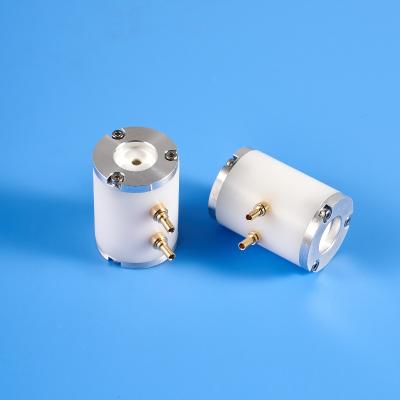Lithium Tantalate Crystal and Its Application - 05
2.2 Fabrication of lithium tantalate crystal with near stoichiometric ratio
The preparation of near-stoichiometric lithium tantalate (NSLT) crystals is difficult. The current methods mainly include: the double crucible method, the flux pulling method, the float zone method and the gas phase exchange equilibrium method.
2.2.1 The double crucible method
In the double crucible method, the melt material needs to be continuously added to the crucible during the crystal preparation process to keep the melt composition unchanged. The NSLT crystal prepared by this method has uniform composition, but the process is complex and the cost is high. At the same time, the solid-liquid interface segregation causes the grown crystal to have a large number of growth stripes.
2.2.2 The flux pulling method
In the flux pulling method, the flux was added to the melt to adjust the crystal melting point. The currently commonly used flux is K2O. This method is less difficult to carry out, but the problem is that the flux will easily enter the crystal. As the flux ratio increases, the components of the melt continue to change with the growth of the crystal, making it difficult to ensure the uniformity of contents in the crystal. Jia et al. successfully grew magnesium-doped lithium tantalate crystals with a near-stoichiometric ratio by using 4% MgO and 14.5% K2CO3 After a 7-day growth process, a MgO-doped SNLT crystal with diameter of ∅50mm and length of 45mm was obtained. Zheng Wei et al. used this method to prepare zinc-doped SNLT crystals with diameter of ∅15mm and length of 10mm.
2.2.3 The float zone method
The float zone method uses thermal energy to create a melting zone at one end of the semiconductor rod, then welds the seed crystal, adjusts the temperature to make the melting zone slowly move to the other end of the rod, and completes crystal preparation through the entire rod. When using this method to prepare NSLT crystals, the volatilization loss of Lithium needs to be considered. When configuring raw materials, r(Li)/r(Nb) needs to be slightly greater than 1. Based on this method, researchers developed the iridium-heating float zone method which has advantages of high raw material utilization rate, low energy consumption, and producing LT crystal with evenly distributed components and good internal quality. Hsu et al. used the horizontal float zone method to grow undoped and MgO-doped LT crystals with near-stoichiometric ratios. This method can also keep the melt composition unchanged during the crystal growth process.
2.2.4 The gas phase exchange equilibrium method
The biggest advantage of the gas phase exchange equilibrium method is that the Li content of the crystal can be controlled during the crystal's growth process. By using this method, LT samples with any known Li content can be obtained according to actual needs. However, this method takes a long time to process the crystals and is only suitable for large sizes. Preparation of thin section samples is difficult to obtain large stoichiometric single crystals. When using this method, Xiao et al. tested the electrical, thermal and mechanical properties of the NSLT wafers and found that as the Lithium increased in the crystal, the conductivity of the LT wafer first decreases, then increases and then decreases. When x (Li) = 49.64% (mole fraction), the maximum conductivity is 4.4×10-12 Ω-1cm-1. By analyzing the thermal and mechanical properties of the SNLT wafers with different x (Li), it was found that the conductivity of the LT wafer first increases and then decreases. The thermal conductivity reaches the maximum value (4.6 W/(m·K)) when x (Li) = 49.75%. The study also found that when x(Li)=49.64%~49.75%, the wafer has better electrical and thermal properties. At the same time, the differential thermal analysis and X-ray photoelectron spectroscopy (XPS) were used to test and analyze the NSLT crystal, and the effect of x (Li) on the Curie temperature and internal defects of the NSLT crystal was studied. The researchers found that when the x (Li) increases, the binding energy corresponding to the Ta+4 electronic layer peak in the XPS spectrum first decreases and then increases, indicating that the proportion of Ta with different valences in the wafer varies with x (Li).



